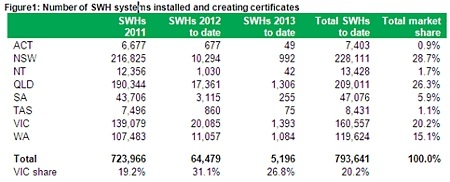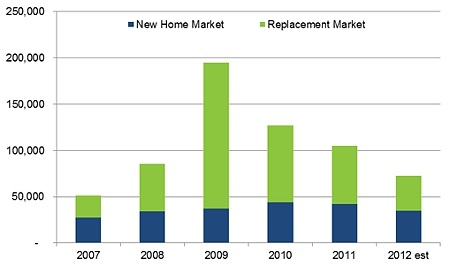Keeping solar water heater growth in check
In early April, the Clean Energy Regulator released the latest data of solar system installations by postcode. In this blog, we assess the Solar Water Heater (SWH) market and provide insights into activity to date.
The data released relates to SWH systems that have been installed and have created certificates to April 5, 2013. (As agents have 12 months from the date of installation to create certificates, the most recent month’s data is not representative of the final level of installations for the month.)
In addition to the one million solar PV installations announced earlier this month, there have been 794,000 SWH systems which have been installed and created certificates in Australia to date. This represents 9 per cent of total dwellings and 14 per cent of owner occupied, detached and semi-detached dwellings with SWH systems.
1. Victoria is currently the largest market for SWHs accounting for 31 per cent of installations in 2012. Queensland and New South Wales have had more systems installed overall, with significant numbers installed in 2008 and 2009 when attractive Commonwealth and state rebates were available for the replacement of electric water heaters.
It may be surprising that Victoria has had the most systems installed recently as it has significant reticulation of natural gas (nearly 80 per cent of homes). The reasonably vibrant SWH market in Victoria is a result of strong growth in the construction of new homes, new home building regulations requiring the installation of either a SWH or rain water tank, and a supportive energy saving (VEET) scheme.

To date, of the 64,500 SWH systems that were installed in 2012 and have created certificates, just over 19 per cent were for heat pump systems. Queensland, South Australia and Tasmania accounted for 29 per cent heat pumps with New South Wales accounting for only 10 per cent.
2. The SWH market in Australia has fallen dramatically in recent years with a total of only 72,500 certificate creating SWH systems expected to be installed in 2012. This amounts to just 37 per cent of the 194,000 SWH systems that created certificates in 2009.
SWH installations in new homes have remained fairly stable over the last five years, with new home building regulations in most states requiring greenhouse efficient water heaters to be installed. The removal of Commonwealth rebates for replacement of electric water heaters and competition for discretionary household expenditure from solar PV are the key reasons for the sharp decline in the replacement market.
Figure 2: SWH systems installed and creating certificates pa

Source: Green Energy Markets report for CER on STC Modelling, February 2013.
Ric Brazzale is Managing Director, Green Energy Trading.
















